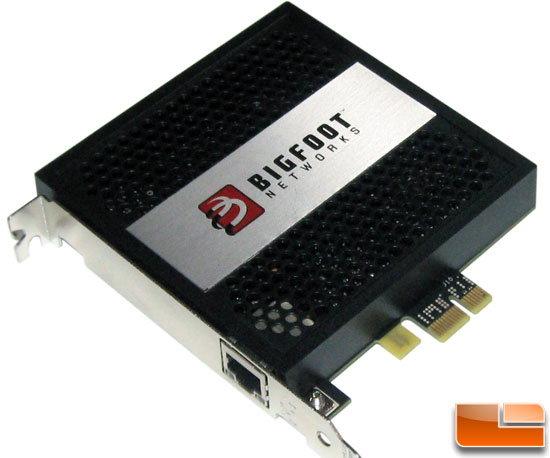Bigfoot Networks Killer 2100 Gaming Network Card Review
By
A Closer Look at the Killer 2100

The Killer 2100 features a simple matte black plastic shroud to cover up the circuitry, with a stainless plate with the Bigfoot Networks logo. The shroud has the same profile as the square 3 7/8″ circuit board. The lone connector on the Killer 2100 is an RJ45 Gigabit Ethernet jack with two built in status lights for link speed and connection status.

Looking at the back of the PCB you can see there is some serious circuitry going on for such a modern NIC.

What the end user will see is the Killer 2100 tag and the stainless side vents.

Upon removing the three screws and shroud we see that there are a number is components that can go on the board; below you will see why.

This picture is of a Killer Xeno Pro NIC, and as you can see they share the same PCB, with the 2100 being stripped of the rear audio ports among several other things.

Looking closer you can see the 128MB of onboard Samsung memory used for packet routing, and the 400MHz Killer 2100 Network Processing Unit. I was curious what the memory was actually used for on the Killer 2100, so I asked Bigfoot Networks and here is the response:
“Some of the Killer
2100 memory is used for data handling. However, the majority of the
memory for the card is used to manage queuing between the different
priority traffic streams. This is one of the key advantages of the
Killer 2100. Queuing becomes critical when there are simultaneous bursts
of traffic that exceed available bandwidth. Without this capability,
these bursts would result in packet loss and increased latency for all
traffic streams. Buffering allows some contention to occur without loss,
while still permitting incredibly high performance for the highest
priority traffic.“
2100 memory is used for data handling. However, the majority of the
memory for the card is used to manage queuing between the different
priority traffic streams. This is one of the key advantages of the
Killer 2100. Queuing becomes critical when there are simultaneous bursts
of traffic that exceed available bandwidth. Without this capability,
these bursts would result in packet loss and increased latency for all
traffic streams. Buffering allows some contention to occur without loss,
while still permitting incredibly high performance for the highest
priority traffic.“

Comments are closed.